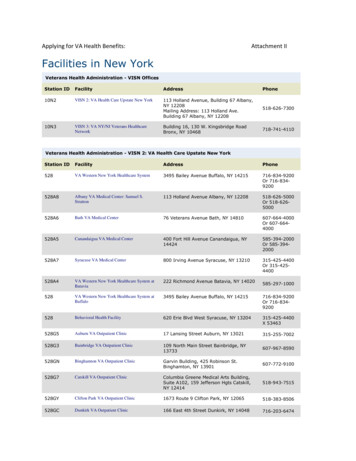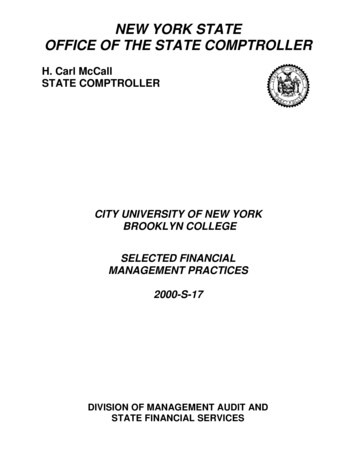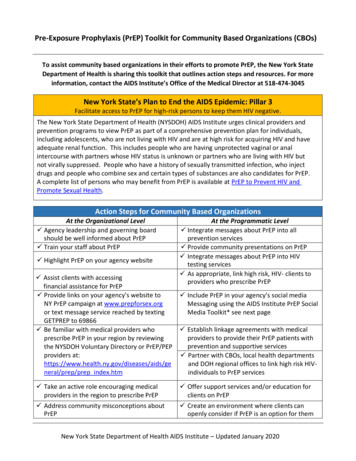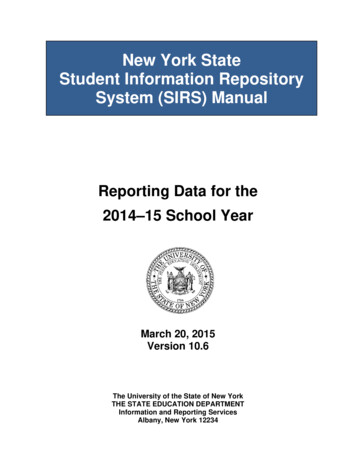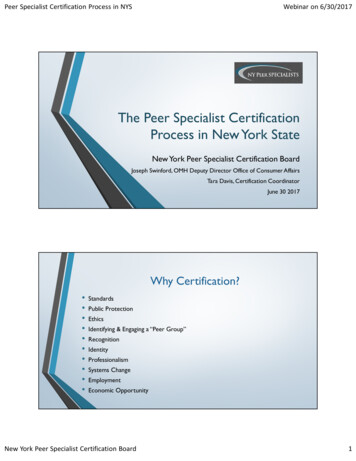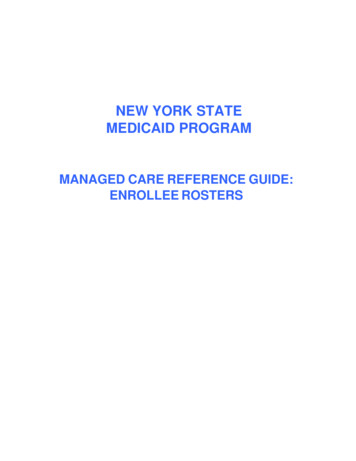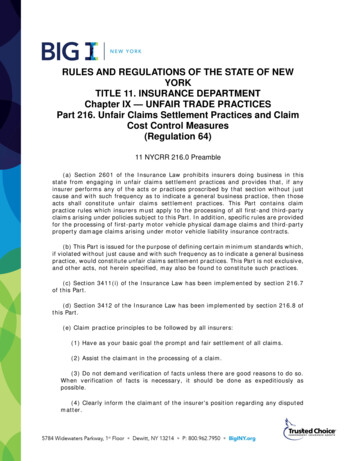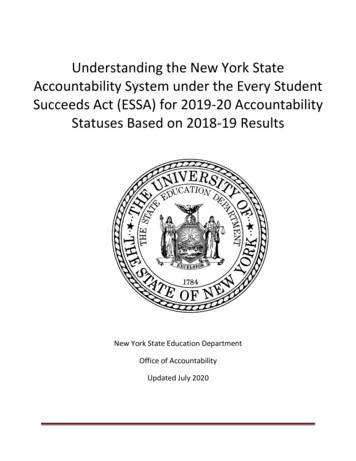
Transcription
Understanding the New York StateAccountability System under the Every StudentSucceeds Act (ESSA) for 2019-20 AccountabilityStatuses Based on 2018-19 ResultsNew York State Education DepartmentOffice of AccountabilityUpdated July 2020
ContentsIntroduction . 1Accountability Statuses . 11.2.3.4.5.6.7.8.9.10.11.12.13.14.15.16.17.What are the school accountability statuses under ESSA? . 1What are the district accountability statuses under ESSA? . 1How often are these statuses determined? . 1What indicators are used to make school and district status determinations? . 1What is an accountability subgroup? . 2How is a school identified as a Comprehensive Support and Improvement (CSI) School?2How is a school identified as a Targeted Support and Improvement (TSI) School? . 3How is a school identified as a School in Good Standing? . 4How is a school identified as a Recognition School? . 4How is a school subgroup identified as Good Standing: Potential TSI? . 5How is a district subgroup identified as Good Standing: Potential TD? . 5How can a school exit Comprehensive or Targeted Support and Improvement status? . 6How is a district identified as a Target District?. 7How is a district identified as a Good Standing: Potential Target District? . 7How is a district identified as a District in Good Standing? . 8How can a district exit Target District status? . 8How is New York City held accountable at the district level? . 8Indicators Used to Make Accountability Determinations . 818. How is a Composite Performance Level determined at the elementary/middle level? . 819. What tests are used to determine Elementary/Middle-Level Composite PerformanceIndices? . 1420. How are student results on Regents exams converted to high school accountability levels?1521. How is a Composite Performance Level determined at the secondary level? . 1522. What tests are used to determine Secondary-Level Composite Performance Indices? . 1723. How is a Student Growth Level determined? . 1824. What tests are used to determine Student Growth? . 1825. How is a Graduation Rate Level determined? . 1826. How is Safe Harbor determined for Graduation Rate? . 2127. How is Accelerated Growth determined for Graduation Rate? . 2228. How is the Combined Composite Performance and Growth Level determined? . 2229. How is the Combined Composite Performance and Graduation Rate Level determined? 2630. How is an English Language Proficiency (ELP) Level determined? . 2931. How is a Progress Level determined? . 3632. How is Safe Harbor determined for the Progress Indicator? . 3833. How is Accelerated Growth determined for the Progress Indicator? . 3934. How is a Chronic Absenteeism Level determined? . 3935. How is Safe Harbor determined for Chronic Absenteeism? . 4136. How is Accelerated Growth determined for Chronic Absenteeism? . 4237. How is the College, Career, and Civic Readiness (CCCR) Level determined? . 4238. How is Safe Harbor determined for College, Career, and Civic Readiness? . 4539. How is Accelerated Growth determined for College, Career, and Civic Readiness? . 46Last updated: July 2, 2020i
Accountability Data Business Rules . 4640. What are Baselines, End Goals, Long-Term Goals, and Measures of Interim Progress(MIPs)? . 4641. How many records must be in a subgroup for a school or district to be accountable for thatsubgroup for an indicator? . 4742. What conditions are used to determine in which accountability subgroup a student isincluded? . 5143. What data are suppressed to protect student confidentiality? . 5244. How are performance levels determined at the elementary/middle level? . 5245. How are performance levels determined at the secondary level? . 5346. How are students who enter New York State schools after Grade 10 included in theaccountability calculations? . 5347. How does ESSA’s 95% participation requirement work in New York State? . 5448. How is accountability status determined for Transfer High Schools? . 5449. How is accountability status determined for Self-Assessment Schools?. 5550. How is accountability status determined for schools with only grades below Grade 3? . 5551. How are the assessment results for advanced middle-school students who take Regentsexams in Grades 7 and 8 included in accountability calculations? . 5552. How are Pathways in Technology (P-Tech) students included in the accountabilitysystem?. 5653. How are students who move into and out of New York State because they are children ofparents or guardians in the military, Military Interstate Compact (MIC) students, includedin the accountability system? . 5654. What if a school or district is newly opened and does not have baseline or other previousyear(s) data? . 5655. What if a school or district does not have a Measure of Interim Progress (MIP) because ofextenuating or extraordinary circumstances?. 56Definitions of Terms Used in the Accountability System . 57Last updated: July 2, 2020ii
IntroductionThe following document provides answers to questions about the New York State Accountability Systemunder the Every Student Succeeds Act (ESSA). In this document, unless stated otherwise, the term“school” refers to public schools registered by the New York State Board of Regents and public charterschools.Accountability Statuses1. What are the school accountability statuses under ESSA?School in Good Standing, Recognition School (a subset of schools in Good Standing), Targeted Support andImprovement (TSI) School, Good Standing: Potential TSI, and Comprehensive Support and Improvement(CSI) School.2. What are the district accountability statuses under ESSA?District in Good Standing, Target District, and Good Standing: Potential Target District.3. How often are these statuses determined?Target Districts, Targeted Support and Improvement Schools, and Recognition Schools are identifiedannually. Comprehensive Support and Improvement designations are made every three years. In thefuture, TSI Schools that consistently fail to show improvement for the subgroup(s) for which the schoolswere identified as TSI will be designated as CSI Schools.4. What indicators are used to make school and district status determinations?School and district statuses are determined using indicators of success.At the elementary/middle (EM) level, these indicators are: Composite Performance: Annual student performance in English language arts (ELA), math, andscience Academic Progress: Progress of students on state assessments in relation to Long-Term Goals andMeasures of Interim Progress (MIPs) in ELA and math Student Growth: Student growth on state assessments in ELA and math for students in grades 48 compared to students with similar scores in prior years English Language Proficiency (ELP): Percentage of students meeting individual progress targetson the New York State English as a Second Language Achievement Test (NYSESLAT) Chronic Absenteeism: Percentage of students who are absent 10% or more instructional daysAt the secondary (HS) level, these indicators are: Composite Performance: Annual student performance in English language arts (ELA), math,science, and social studies Academic Progress: Progress of students on state assessments in relation to Long-Term Goals andMeasures of Interim Progress (MIPs) English Language Proficiency (ELP): Percentage of students meeting individual progress targetson the New York State English as a Second Language Achievement Test (NYSESLAT) Chronic Absenteeism: Percentage of students who are absent 10% or more instructional days Graduation Rate: Graduation rates of students four, five, and six years after first entering grade9 as of August 31 of the preceding reporting year (lagged year data) College, Career, and Civic Readiness (CCCR): Percentage of students who are leaving high schoolprepared for college, career, and civic engagement as measured by diplomas, credentials,Last updated: July 2, 20201
advanced course credits and assessment results, career and technical education certifications,and other achievementsUnder ESSA, the New York State accountability system assigned a Level from 1 to 4 to each accountabilitysubgroup for each indicator for which a school or district is accountable based on the subgroups’performance on the indicators, where 1 indicates the lowest performance and 4 indicates the highestperformance. These levels are used to determine a school’s and a district’s accountability status basedon the level of performance assigned to subgroups for which the school or district is accountable.5. What is an accountability subgroup?An accountability subgroup is a group of students who are assigned to a certain category based on theirrace/ethnicity, English language proficiency, disability status, or economic status. The accountabilitysubgroups are: All Students, American Indian or Alaska Native, Black or African American, Hispanic orLatino, Asian or Native Hawaiian/Other Pacific Islander, White, Multiracial, Economically Disadvantaged,English Language Learner (ELL), and Students with Disabilities.A student will always be classified as belonging to the All Students group and one of the racial/ethnicgroups.In addition, certain students will also be classified as an economically disadvantaged student, an Englishlanguage learner, and/or a student with a disability.6. How is a school identified as a Comprehensive Support and Improvement (CSI)School?A minimum of five percent of elementary/middle schools in the state, which must include at least fivepercent of elementary/middle schools receiving Title I, Part A funds, AND a minimum of five percent ofhigh schools in the state, which must include at least five percent of high schools receiving Title I, Part Afunds, will be identified every three years as in need of comprehensive support and improvement.CSI identification criteria: CSI identifications are based on the performance of all students in the school (i.e., the All Studentsgroup only) and are made every three years, beginning with the 2018-19 school year using 201718 school year results.1 CSI identifications will be made again in the 2021-22 school year using2020-21 school year results. Elementary/middle schools are preliminarily identified as CSI if the All Students group meets anyof Scenarios 1-5 in the Elementary/Middle School CSI Identification Criteria table below. High schools are preliminarily identified as CSI if the All Students group meets any of Scenarios 15 in the High School CSI Identification Criteria table below. High schools are also preliminarily identified as CSI if their 4-year graduation rate is below 67percent and their 5-year or 6-year graduation rates are not at or above 67%. Districts may petition the Commissioner to not identify a preliminarily identified school if thedistrict believes that there are extenuating or extraordinary circumstances that warrant theschool not being identified as a CSI. Following the review of any appeals, the Commissioner makesfinal determinations regarding the status of preliminarily identified schools.1An identified school that serves both elementary/middle and high school grades is counted as a high school for thispurpose regardless of whether the school has been identified for the performance of its elementary/middle or highschool students.Last updated: July 2, 20202
Elementary/Middle School CSI Identification Methods:1) Elementary/middle schools are preliminarily identified as CSI Schools if they demonstrate anycombination of levels on indicators in the scenarios listed in the table below.Elementary/Middle School CSI Identification CriteriaCombined nce & GrowthAbsenteeismAny Level1Both Level 1Level 1Any Level (None, 1-4)(None, 1-4)2Either Level 1Level 1None*Any One of the Two is Level 13Either Level 1Level 1Level 1Any Level (None, 1-4)4Either Level 1Level 1Level 2Any One of the Two is Level 15Either Level 1Level 1Level 3 or 4Both Level 1Note: The accountability status for schools that do not have a Composite Performance level will be determined usinga separate Self-Assessment process.*“None” means the school does not have sufficient English Language Learners (30 results) to assign an accountabilitylevel for the ELP indicator.CompositePerformance2) Elementary/middle TSI Schools with chronically low performing subgroups, that have beenidentified for additional targeted support, and have not shown a specified level of improvementover three years, may also be identified as CSI Schools.High School CSI Identification Methods:1) High schools that have graduation rates for the 4-year graduation rate total cohort that are lessthan 67% and do not have graduation rates for the 5-year or 6-year graduation rate total cohortsthat are at or above 67% are automatically preliminarily identified as CSI Schools.2) High schools are preliminarily identified as CSI Schools if they demonstrate any of the combinationof levels on indicators as indicated in the table below.High School CSI Identification CriteriaCombined e & Grad RateAbsenteeismAny Level1Both Level 1Level 1Any Level (None, 1-4)(None, 1-4)2Either Level 1Level 1None*Any One of the Three is Level 13Either Level 1Level 1Level 1Any Level (None, 1-4)4Either Level 1Level 1Level 2Any One of the Three is Level 15Either Level 1Level 1Level 3 or 4Any Two of the Three are Level 1Note: The accountability status for schools that do not have a Composite Performance level will be determined using a separateSelf-Assessment process.*“None” means the school does not have sufficient English Language Learners (30 results) to assign an accountability level forthe ELP indicator.CompositePerformanceGradRate3) TSI high schools with chronically low performing subgroups that have been identified foradditional targeted support and have not shown a specified level of improvement over three yearsmay also be identified as CSI Schools.Note: A school identified for graduation rate (method 1) can also be identified based on levels(method 2).7. How is a school identified as a Targeted Support and Improvement (TSI) School?The same method(s) used to identify Comprehensive Support and Improvement (CSI) Schools are used toidentify TSI Schools. However, TSI identifications are based on the performance of subgroups, not the AllStudents group, and are made annually based on a subgroup’s performance in the past two years.Last updated: July 2, 20203
TSI identification criteria:1) TSI identifications are based on the performance of the accountability subgroups, not the AllStudents group. These subgroups are: American Indian or Alaska Native, Black or AfricanAmerican, Hispanic or Latino, Asian or Native Hawaiian/Other Pacific Islander, White, Multiracial,English Language Learner (ELL), Students with Disabilities (SWD), and EconomicallyDisadvantaged.2) The same Scenarios that are used to preliminarily identify Comprehensive Support andImprovement Schools are used to preliminarily identify schools as TSI.3) A school was preliminarily identified as TSI in the 2018-19 school year if the school was in PrioritySchool or Focus School accountability status in the 2017-18 school year and if any of the school’saccountable subgroups met one of the aforementioned scenarios using 2017-18 school yearresults.4) If a school was in Good Standing in the 2018-19 school year and if any of the school’saccountability subgroups met one of the aforementioned scenarios based on 2018-19 school yearresults, the school is preliminarily identified as Potential TSI for the 2019-20 school year.5) If a school meets both the CSI criteria for the All Students group and the TSI criteria for anyaccountability subgroup(s), the school is identified as CSI.6) As with CSIs, districts may petition the Commissioner to not identify a preliminarily identifiedschool if the district believes that there are extenuating or extraordinary circumstances thatwarrant the school not being identified as a TSI. Following review of any appeals, theCommissioner makes final determinations regarding the status of preliminarily identified schools.8. How is a school identified as a School in Good Standing?1) A school that is not identified as a TSI or CSI School is automatically in Good Standing. Someschools in Good Standing will be identified as Recognition Schools.2) If a school that was in Good Standing in the 2018-19 school year meets the CSI criteria for the AllStudents group based on 2018-19 school year results, the school remains in Good Standing in the2019-20 school year. If this school meets the TSI criteria in the 2019-20 school year for any of thesame subgroup(s) for which it met the TSI criteria in the 2018-19 school year, the school will beidentified as TSI in 2020-21.9. How is a school identified as a Recognition School?A school that is in Good Standing and is high-performing or rapidly improving as determined by theCommissioner is designated a Recognition School. To be identified as a Recognition School, a school mustmeet the following cr
Feb 11, 2020 · prepared for college, career, and civic engagement as measured by diplomas, credentials, Last updated: July 2, 2020 2 advanced course credits and assessment results, career and technical education certifications,
